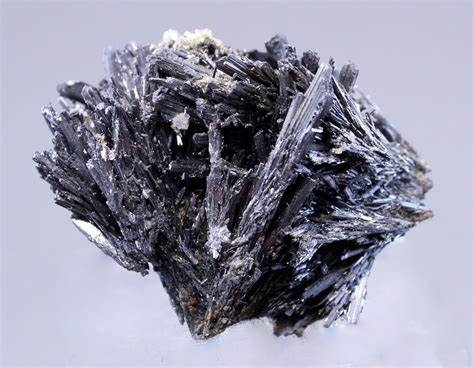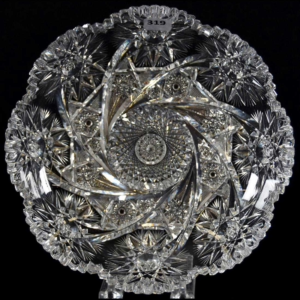Stibnite Stone – properties, virtues & benefits
Stibstone, also known as black antimony, is a semi-metallic mineral rarely used in industry. Its metallic black color and electrical conductivity make it an interesting material for certain electronic applications. However, it is mainly used for scientific research purposes. Find out more about the properties and uses of Stibine Stone in this article.
CHARACTERISTICS OF THE STIBINE
- Chakra: Third eye.
- Properties: semi-metallic, electrical conductivity.
- Astrology: Saturn.
- Zodiac: Capricorn.
- Elements: Air and Earth.
- Colors: Metallic black.
- Hardness: 3 on the Mohs scale.
- Chemical Formula: Sb2S3 (antimony sulfide).
- Associated god: /
STIBINE – HIS HISTORY
The first written mention of stibine stone dates back to the year 77 in the writings of Pliny the Elder. Later, François SulPice Beudant introduced the term stibine, derived from the Greek word “Stibi”. The type locality for this mineral is Ichikawa, in the Shikoku deposit of Japan, but the mine is now exhausted. Stibine deposits still exist in South America, in Mexico, Bolivia and Peru. The ancient Egyptians used this metal to coat copper vessels for transporting water during the 5th and 6th Dynasties of the Pharaohs. Excavations have also revealed a Chaldean vase fashioned entirely from this mineral.
Antimony is mentioned in the Bible, as Jezebel used this mineral to make up her eyes. It was a common hygienic and aesthetic practice among certain ancient peoples. The Chinese, Romans and Greeks also used this mineral for various treatments. In the 16th century, the monk Basil Valentin described in his pamphlet the benefits of this metal and its action on the purification of gold. Basil even claimed that the same purifying effects could be observed on the human body.
Until the second half of the 16th century, the misuse of compounds based on this mineral led to many deaths. Eventually, the faculty of Paris banned their use. The widespread use of antimony-based compounds gave rise to an original derivative vocabulary that is still used in some cases today. For example, trioxide was called “silver flowers” and pentasulfide was called “golden sulfur”. Other strange appellations included “Algaroth powder” for oxychloride and “antimony butter” for trichloride.
The main fame of this ore comes from the work of the alchemists, for whom it was a primordial material and had several names, such as “gray wolf of the philosophers”, “matter of the sages” and “natural son of Saturn”. It was considered the penultimate step in the process of achieving perfection by transmuting an impure metal into gold. Today, organic derivatives of this mineral are still used to treat various internal parasitic infestations.

STIBINE STONE – ITS ORIGIN AND COMPOSITION
This is a category 2 mineral species belonging to the same series as bismuthinite. It is composed of antimony sulfide with an ideal formula of Sb2S3. The chemical symbol of its element is Sb and its atomic number is 51. It also contains traces of copper, zinc, lead, iron, titanium and other metals. This sulfide has been used for cosmetic purposes for many centuries to make eye shadow and mascara. Even today, it is used in pyrotechnics to produce a sparkling effect. This silvery-metallic mineral is highly lustrous, sometimes showing bluish or iridescent reflections in the presence of alterations. It is an opaque metal with a hardness of 2 on the Mohs scale. Its formation occurs at low temperatures, between 500 and 200°C, far below the earth’s surface.
Contrary to many other metals, it does not tarnish on contact with ambient air. It is a very poor electrical and thermal conductor. It is found in very small quantities in the earth’s crust, its concentration not exceeding 0.7%, and is more present at the surface. This mineral is considered one of the non-renewable natural resources that will soon disappear. There are several versions concerning the origin of this mineral’s name. Some believe it comes from the mixture from which the ore is extracted. Others believe that the name comes from the monk Basilius Valentinus, who was the first to share the virtues of the stibine stone with his peers.
.
Since ancient times, this mineral has been used for a variety of purposes, such as the manufacture of Babylonian pottery or Egyptian eye shadow. The Mesopotamians used a yellow Pigment that required the presence of this mineral in its manufacture. In ancient Rome, it was used as an emetic in the form of potassium antimonyltartrate, and was particularly appreciated at orgies and banquets. Alchemists were fascinated by this mineral because of its brilliance and purity of color, assuming that transmuting it into silver and gold would be a simple task. The stibine stone was therefore studied and used in every possible way by alchemists right up to the 18th century.
Diderot and d’Alembert’s Encyclopédie devotes an entire chapter to this metal, describing its uses and virtues in detail. Meticulously used calcination of the ore could treat sphylitic Pimples. Chloride, with its caustic properties, could be used to clean certain wounds such as bites, or to burnish certain metals. Apothecaries of the time could use a mixture of sulfides and oxysulfides called kermes. The book also describes the preparation of medicinal products such as antinomium ressucitatum, which was highly effective in calming maniacs. Golden soufres were reputed to be truly universal remedies and were recommended for a wide range of physical ailments.
For a long time, preparations based on this metal were in the form of small beads to be swallowed or dissolved in infusions, known as perpetual Pills, passed down from generation to generation. However, these preparations caused numerous undesirable side effects, prompting the Paris faculty and parliament to ban their use in 1566. A century later, in the face of strong demand, a new ruling authorized their use once again. Madame de Sévigné, among others, consumed it daily in the hope of prolonging her youth.
Today, this metal is used in a wide variety of fields, with China as the main producing country, producing 170 Kilotonnes per year. It is commonly used in welding and for the preparation of various alloys. It adds sparkle to fireworks and is used to color glass. It is also present in lead-acid batteries and electrodes. It is used in the polymerization process required to manufacture certain fruit juice and water bottles. Its trioxide is also used in the textile industry to make fabrics flame-retardant, and as a catalyst in the manufacture of certain polyesters. In the field of electronics, this mineral participates in the manufacture of conductors and semiconductors by modulating their electrical properties.
.
However, unlike arsenic, this ore is highly toxic, and its various degrees of oxidation make it a major and dangerous pollutant with a negative impact on the environment. This crystal contains lead sulfide, so it must be handled with care, and its industrial use can cause pollution due to the emission of oxide particles.
.
STIBINE STONE – VERTIES AND PROPERTIES
PSYCHOLOGICAL STIBINE
The stibine stone, also known as antimony, can have a profound and all-encompassing effect on the wearer. As a stone of attraction and transformation, it can also aid personal growth and self-confidence. However, to avoid undesirable effects, it is important to clearly define what you wish to attract into your life before using it. The stibine stone emits a cleansing and protective energy linked to the earth, which can be used to amplify vibratory energies and strengthen the auric field. It also offers protection against attachments and possessions.
With the help of a pendulum to check its purity, stibine stone can be used to remove entities. However, it’s important to know how to handle a pendulum with precision. Stibine stones should not be exposed to water or salt. The positive powers of the crystal can help to regulate inner frequencies and tap one’s own potential. The liberating power of the stibine stone can help focus on what needs to be accomplished.
PHYSICAL STIBINA
The stibine stone, endowed with attractive and transformative properties, has positive effects on personal fulfillment and self-confidence. It is important to clearly specify the objective before using it to avoid negative effects. This powerful crystal can be used for manifestation and to amplify vibratory energies by strengthening the auric field, bringing new courage and offering protection against attachment and possession. However, it should not be used with water or salt.
Stibine also has beneficial properties for blood circulation and the digestive system. It is useful for promoting adaptation to environmental changes and improving mental well-being by helPing to bring order to chaos. It can also help eliminate emotional and physical toxins from the body and enhance meditations and sPiritual experiences.
Stibine can also be used for accurate diagnoses and to help the body better resist changes in energy frequencies. In cases of viruses or bacteria, esophageal tension or stomach disorders, it can be a valuable aid.
STIBINE STONE – CLEAN AND RECHARGE
Stibine Stone is a semi-metallic mineral that can be cleansed and recharged to maintain its energetic properties. Here are some common methods for cleansing and recharging Stibine Stone:
Cleaning:
- Distilled water: Rinse the stone with distilled water to remove any dirt or dust build-up.
- Fumigation: Use sage or palo santo to clean the stone with smoke.
Loading:
- Solar light: Place the Stibine Stone in a sunny spot for a few hours to recharge it with solar energy.
- Moonlight: Place the stone under the light of the full moon to recharge it with lunar energy.
- Earth: Bury the stone in the ground for a few days to recharge it with earth energy.
It is important to note that Stibine Stone should not be cleaned with salt water, as this can damage its surface. In addition, regular cleaning and recharging of the Stibine Stone is recommended to maintain its optimal energetic properties.
WHERE DOES THE NAME STIBINE COME FROM?
The name “stibine” comes from the Latin “stibium”, meaning antimony. Stibine is a chemical compound made up of antimony and hydrogen, with the chemical formula SbH3. It is also known as hydrogen antimonide. The term “stibine” is commonly used to designate this compound, although other names have also been used in the past, such as “antimonous hydrogen” or “antimonous tri-hydruro”.
WHICH CHAKRA DOES STIBINE ACT ON?
Stibine is not usually associated with a specific chakra in the tradition of Ayurvedic medicine or in yoga practice. Chakras are subtle energy centers located along the sPine, and they are often associated with specific stones, colors and healing practices.
WHICH ASTROLOGICAL SIGN IS ASSOCIATED WITH STIBIN?
I am not aware of any association between stibine and a specific astrological sign. Stibine is a chemical compound consisting of antimony and hydrogen and has no known astrological relationship.
In astrology, each sign is generally associated with certain stones, colors and planets, but this is based on different beliefs and traditions, and there is no universal consensus on these associations. It should also be noted that astrology is not supported by science and has no basis in fact.
STIBIN STONE SUMMARY
Stibine stone, also known as antimony, is a chemical element with the symbol Sb and atomic number 51. It is a metalloid, meaning it has both metallic and non-metallic properties.
Antimony has been used since ancient times in a variety of applications, such as the manufacture of cosmetics, medicines, Pigments and metal alloys. It is also used in batteries, semiconductors and flame retardants.
Antimony can be toxic to humans and the environment if used incorrectly or in large quantities. It can cause resPiratory, gastrointestinal and cardiac problems in humans, and can contaminate soil and waterways.
Stib stone is often associated with myths and legends, not least because of its distinctive appearance and unusual properties.

